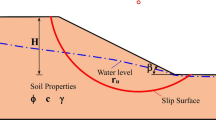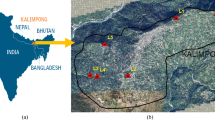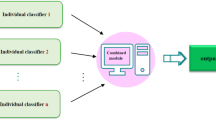Abstract
Within the field of geotechnical engineering, complex challenges arise due to uncertainties associated with variable loads, soil properties, ground stratification, and other related factors. In order to effectively address these uncertainties, it is recommended to employ reliability analysis based on probabilistic methodologies. The objective of this study is to investigate the effectiveness of ensemble machine learning methods in predicting the factor of safety (FOS) for railway embankments. The FOS is a critical indicator of the stability of cohesive slopes. By utilizing the recently developed Subset Simulation (SS) method for reliability analysis, we aim to investigate the potential of machine learning in improving predictions of FOS (Factor of Safety). We have obtained a comprehensive dataset consisting of 1400 instances from the subset simulation evaluation. This dataset serves as the foundation for our investigation. In the context of machine learning, we employ six commonly used methodologies, namely decision tree regression (DTR), multiple linear regression (MLR), K nearest neighbor regression (KNN), random forest regression (RF), extreme gradient boosting regression (XGB), and support vector regression (SVR), to develop predictive models for extrapolating FOS values. Afterwards, we utilize ensemble machine learning techniques to combine the outputs of these individual predictive models. Among the various ensemble strategies, the voting ensemble (VO-ENSM) stands out as a strong candidate, demonstrating significant proficiency in predicting the Factor of Safety (FOS) for the complex terrain of railway embankments.








Similar content being viewed by others
Data availability
Data will be made available to the reader on reasonable request.
References
Al-Qahtani FH, Crone SF (2013) Multivariate k-nearest neighbour regression for time series data—A novel algorithm for forecasting UK electricity demand. In: The 2013 international joint conference on neural networks (IJCNN). pp 1–8
Ang AHS, Tang WH (1984) Probability concepts in engineering planning and design Decision risk and reliability. Wiley, New York
Asare EN, Affam M, Ziggah YY (2023) A hybrid intelligent prediction model of autoencoder neural network and multivariate adaptive regression spline for uniaxial compressive strength of rocks. Model Earth Syst Environ 1:1–17
Au S-K, Beck JL (2001) Estimation of small failure probabilities in high dimensions by subset simulation. Probabilistic Eng Mech 16:263–277
Au S-K, Wang Y (2014) Engineering risk assessment with subset simulation. Wiley, UK
Au SK, Ching J, Beck JL (2007) Application of subset simulation methods to reliability benchmark problems. Struct Saf 29:183–193. https://doi.org/10.1016/j.strusafe.2006.07.008
Au SK, Cao ZJ, Wang Y (2010) Implementing advanced Monte Carlo simulation under spreadsheet environment. Struct Saf 32:281–292
Baecher GB, Christian JT (2005) Reliability and statistics in geotechnical engineering. Wiley, USA
Bardhan A, Samui P (2022) Probabilistic slope stability analysis of Heavy-haul freight corridor using a hybrid machine learning paradigm. Transp Geotech 37:100815. https://doi.org/10.1016/j.trgeo.2022.100815
Behar O, Khellaf A, Mohammedi K (2015) Comparison of solar radiation models and their validation under Algerian climate–The case of direct irradiance. Energy Convers Manag 98:236–251
Breiman L, Friedman JH (1997) Predicting multivariate responses in multiple linear regression. J R Stat Soc Ser B (Statistical Methodol) 59:3–54
Cao Z, Wang Y, Li D (2017) Probabilistic approaches for geotechnical site characterization and slope stability analysis. Springer, Berlin
Chai T, Draxler RR (2014) Root mean square error (RMSE) or mean absolute error (MAE)?–Arguments against avoiding RMSE in the literature. Geosci Model Dev 7:1247–1250
Chang Y-C, Chang K-H, Wu G-J (2018) Application of eXtreme gradient boosting trees in the construction of credit risk assessment models for financial institutions. Appl Soft Comput 73:914–920
Christian JT, Ladd CC, Baecher GB (1994) Reliability applied to slope stability analysis. J Geotech Eng 120:2180–2207
Cornell CA (1972) First-order uncertainty analysis of soil deformation and stability. Transportation research board, University of Hong Kong
Ditlevsen O (1981) Uncertainty modeling with applications to multidimensional civil engineering systems. McGraw-Hill International Book Company, USA
El-Ramly H, Morgenstern NR, Cruden DM (2002) Probabilistic slope stability analysis for practice. Can Geotech J 39:665–683
Engelund S, Rackwitz R (1993) A benchmark study on importance sampling techniques in structural reliability. Struct Saf 12:255–276
Fenton GA, Griffiths DV et al (2002) Probabilistic foundation settlement on spatially random soil. J Geotech Geoenvironmental Eng 128:381–390
Fishman GS (1996) Random Tours. In: Monte Carlo. Springer series in operation research, pp 335–491
Hammersley JM, Handscomb DC (1964) The general nature of Monte Carlo methods. Monte Carlo methods. Springer, Berlin, pp 1–9
Hammersley JM, Handscomb DC (1964) Percolation processes. In: Jesy C (ed) Monte Carlo Methods. Springer, Berlin, pp 134–141
Harr ME (1984) Reliability-based design in civil engineering. Department of Civil Engineering, School of Engineering, North Carolina State
Hasofer AM, Lind NC (1974) Exact and invariant second-moment code format. J Eng Mech Div 100:111–121
Hastings WK (1970) Monte Carlo sampling methods using Markov chains and their applications. Biometrika 57(1):97–109
Kardani N, Aminpour M, Raja MNA et al (2022) Prediction of the resilient modulus of compacted subgrade soils using ensemble machine learning methods. Transp Geotech 36:100827
Kulhawy FH (1992) On the evaluation of soil properties. ASCE Geotech Spec Publ 1:95–115
Legates DR, McCabe GJ (2013) A refined index of model performance: a rejoinder. Int J Climatol 33:1053–1056
Low BK (2003) Practical probabilistic slope stability analysis. Proceedings, Soil Rock Am 12:22–26
Low BK, Tang WH (1997a) Probabilistic slope analysis using Janbu’s generalized procedure of slices. Comput Geotech 21:121–142
Low BK, Tang WH (1997b) Efficient reliability evaluation using spreadsheet. J Eng Mech 123:749–752
Low BK, Tang WH (2004) Reliability analysis using object-oriented constrained optimization. Struct Saf 26:69–89
Low BK, Tang WH (2007) Efficient spreadsheet algorithm for first-order reliability method. J Eng Mech 133:1378–1387
Lumb P (1974) Application of statistics in soil mechanics. Soil Mech New Horizons IK Lee, ed
Malkawi AIH, Hassan WF, Abdulla FA (2000) Uncertainty and reliability analysis applied to slope stability. Struct Saf 22:161–187
Melchers RE, Beck AT (2018) Structural reliability analysis and prediction. Wiley, USA
Metropolis N, Rosenbluth AW, Rosenbluth MN et al (1953) Equation of state calculations by fast computing machines. J Chem Phys 21:1087–1092
Phoon K-K (2008) Reliability-based design in geotechnical engineering: computations and applications. CRC Press, Florida
Raghuram G, Verma A (2019) Dedicated freight corridor: current challenges. In: World Conference on Transport Research-WCTR
Ren Y, Zhang L, Suganthan PN (2016) Ensemble classification and regression-recent developments, applications and future directions. IEEE Comput Intell Mag 11:41–53
Ribeiro MHDM, dos Santos Coelho L (2020) Ensemble approach based on bagging, boosting and stacking for short-term prediction in agribusiness time series. Appl Soft Comput 86:105837
Robert CP, Casella G, Casella G (1999) Monte Carlo statistical methods. Springer, Berlin
Schuëller GI, Pradlwarter HJ (2007) Benchmark study on reliability estimation in higher dimensions of structural systems–an overview. Struct Saf 29:167–182
Sihag P, Al-Janabi AMS, Alomari NK et al (2021) Evaluation of tree regression analysis for estimation of river basin discharge. Model Earth Syst Environ 7:1–13
Singh A (1972) How reliable is the factor of safety in foundation engineering, Soil Mechanics-new horizons. Newness Butterworths 1974, pp 44–111
Sivakumar Babu GL, Mukesh MD (2004) Effect of soil variability on reliability of soil slopes. Geotechnique 54:335–337
Stone RJ (1993) Improved statistical procedure for the evaluation of solar radiation estimation models. Sol Energy 51:289–291
Tamiru H, Wagari M (2022) Machine-learning and HEC-RAS integrated models for flood inundation map** in Baro River Basin, Ethiopia. Model Earth Syst Environ 8:2291–2303
Tang WH, Yucemen MS, Ang A-S (1976) Probability-based short term design of soil slopes. Can Geotech J 13:201–215
Tso GKF, Yau KKW (2007) Predicting electricity energy consumption: A comparison of regression analysis, decision tree and neural networks. Energy 32:1761–1768
Wang Y, Cao Z, Au S-K (2011) Practical reliability analysis of slope stability by advanced Monte Carlo simulations in a spreadsheet. Can Geotech J 48:162–172
Willmott CJ (1984) On the evaluation of model performance in physical geography. Spatial statistics and models. Springer, Berlin, pp 443–460
Wong FS (1985) Slope reliability and response surface method. J Geotech Eng 111:32–53
Yahyaoui N, Neji M, Kallel M et al (2023) A comparative approach of ML algorithms to rank irrigation water quality: case of Oriental-Coast shallow aquifer in Cap-Bon, northeastern of Tunisia. Model Earth Syst Environ 9:1–14
Acknowledgements
The authors express their sincere gratitude to Prof. Siu-Kui Au, University of Liverpool, UK; Prof. Yu Wang, City University of Hong Kong, China and Prof. Zijun Cao, Wuhan University, China, for providing the MS-Excel Add-In UPSS module which has been used in the present work.
Funding
There has been no external funding.
Author information
Authors and Affiliations
Contributions
FA: Research Methodology, Resources, Software, Validation, Visualization, Original Draft, Review & Editing Writing; PS: Guidance. SSM: Guidance.
Corresponding author
Ethics declarations
Conflict of interest
No one declared.
Additional information
Publisher's Note
Springer Nature remains neutral with regard to jurisdictional claims in published maps and institutional affiliations.
Appendix
Appendix
Rights and permissions
Springer Nature or its licensor (e.g. a society or other partner) holds exclusive rights to this article under a publishing agreement with the author(s) or other rightsholder(s); author self-archiving of the accepted manuscript version of this article is solely governed by the terms of such publishing agreement and applicable law.
About this article
Cite this article
Ahmad, F., Samui, P. & Mishra, S.S. Probabilistic slope stability analysis using subset simulation enhanced by ensemble machine learning techniques. Model. Earth Syst. Environ. 10, 2133–2158 (2024). https://doi.org/10.1007/s40808-023-01882-4
Received:
Accepted:
Published:
Issue Date:
DOI: https://doi.org/10.1007/s40808-023-01882-4












